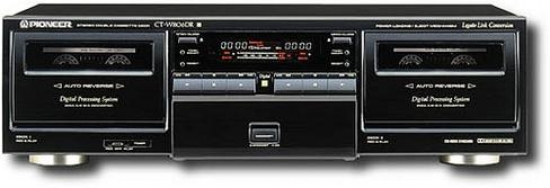Pioneer CT-W806DR Cassette deck
I have such impressions from the work with CT-W806DR that want to share. Let's start from the main point - the digit. In this device digital technologies came to help analog record. Judge for yourself: Digital TDNS - digital noise reduction while coping, Digital FLEX - a digital compensator of high frequencies, Digital ALCA - a digital optimizer of record level under the parameters of the tape, Digital Super Auto BLE XD - a digital optimizer of level of magnetic bias under parameters of the tape, and, finally, Digital NR - an original digital noise limiter. An optical digital input connector deserves a special attention.
Other noticeable improvements are the motorized loading of cassettes, the possibility of mixing from a microphone, search by pauses up to ± 15 fragments, parallel recording on both mechanisms, two modes of counters (including real time), timer. There is also DEMO mode, which will not only simplify the learning, but will clear up all the elements of indication.
With such an expanded functional richness also there are generally accepted equipment like Dolby B, C, HX-Pro systems, all the variants of reverse work, including Relay Record when coping, synchro-recording from CD and the indicator of the level with peak holding.
Considering the number of innovations, being used in this device, that interest, with which we proceeded to its estimates, is not surprising. And, of course, we started from the digital DSP-processor, promising to cardinally improve the quality of sound, bringing it closer to digital. And I must say, these expectations were fully confirmed. At least signal/noise ratio -78dB with disabled Dolby system means something. Turning Dolby on improves signal/noise ratio up to 83 dB. It is interesting that the difference between Dolby B and C with powered digital processing is minimal (about 1 dB). Not CD, of course, but not bad. But let's move from dry digits to subjective listening - it's not a secret that the showiness of any of noise reduce system can really be assessed only audibly, because all noise limiters use subjective physiological characteristics of human ear. Let us say at once that the algorithm, used in DSP, is perfect enough. It work appears in the form of typical noise tails (by the way, much less noticeable than in analog noise reducers) on the sharp and dynamic solo instruments, for example, guitar passages. For reducing their visibility it was enough to record a phonogram without Dolby B - in this case "tails" almost disappeared. In short, it's not surprising that the developers did not add a separate button for turning DSP off (a bright green LED in the center of control panel signalizes that processing is turn on). To our mind, the need to turn it off can appear very rarely, for example, on a very noisy track, when noise reducer's work is too noticeable. Let's tell briefly about what we disliked. Despite of the availability of a cool optimization system of record path, a received amplitude-frequency response has a strong overshoot on the highest frequencies (ab. 19 kHz). The quality of rewriting at double speed greatly cut off the frequency - in fact this mode can be recommended only for rewriting of speech information and with a hook at the end. However, considering the excellent results of digital noise reducer, we did not lower a resulting estimation for the quality of quickened copying.




